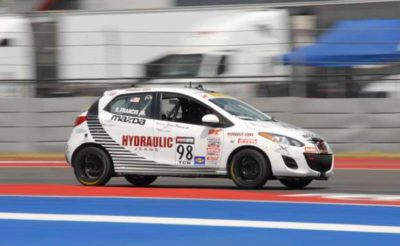The B-Spec class in SCCA Club Racing and the corollary Pirelli World Challenge Touring Car B Championship have been gaining momentum and popularity. One of the more popular weapons chosen for the racing class designed to be low-cost and great for beginning racers is the Mazda2.
No team has used the Mazda2 to better effect than the Breathless Performance team that includes founder Ernie Francis and his son, Ernie Francis Jr. Ernie Jr. has won more than half the races in the season so far, has two additional podiums and is leading the championship after the Sonoma races. Ernie Sr. has been doing pretty well himself, scoring three podium finishes. In addition, the team fields two more Mazda2s for other drivers.
Breathless Performance has been building racecars for many years, and once had a fleet of 10 Spec Miatas for rental. Ernie Jr. got his start racing in the National Auto Sport Association in Spec Miata when he was 13. As he approached eligible age to race in World Challenge, Breathless Performance built a B-Spec Mazda2. Ernie Sr. got his hands on it first, winning the first race that B-Spec was eligible to participate in the Grand-Am Continental Tire Sports Car Challenge at Homestead last year.
B-Spec is basically a showroom stock class, with parts substitutions chosen by the manufacturers and approved by the sanctioning bodies that are designed to make the cars a bit more lively and fun to drive – not to mention safer. One of the few free areas – although within strict safety rules – is the rollcage. That, says Ernie Sr. can be pretty critical in building a Mazda2 B-Spec car.
“It’s not that hard to build this project,” he says. “The main thing is you’re going to have to find someone to build you a decent cage that makes the car stiff enough and also for safety. The cage is very important in getting the design right and getting everything out of the car. It should be as light as you can legally and safely make it. Then you can add weight back into the car in a position where it’s going to benefit you.”
That position is in the only place that sanctioning bodies usually allow ballast to be placed – on the passenger-side floorboard. That balances the weight of the driver and makes the crossweights closer to 50-50.
From there, since there isn’t much you can do about straight-line speed, it’s all about making the car corner as well as possible.
“If someone ever sees what our team does at the racetrack, we’re probably checking the alignment settings on the car 10 or 15 times, over and over again, to make sure we have our camber settings correct, our toe settings correct,” says Ernie Sr. “The driver is going to give us feedback on how the turn-in is. That’s very important; that’s what’s giving us the edge out there, because we’re able to get these cars to turn in and to grip the way we need them to.”
